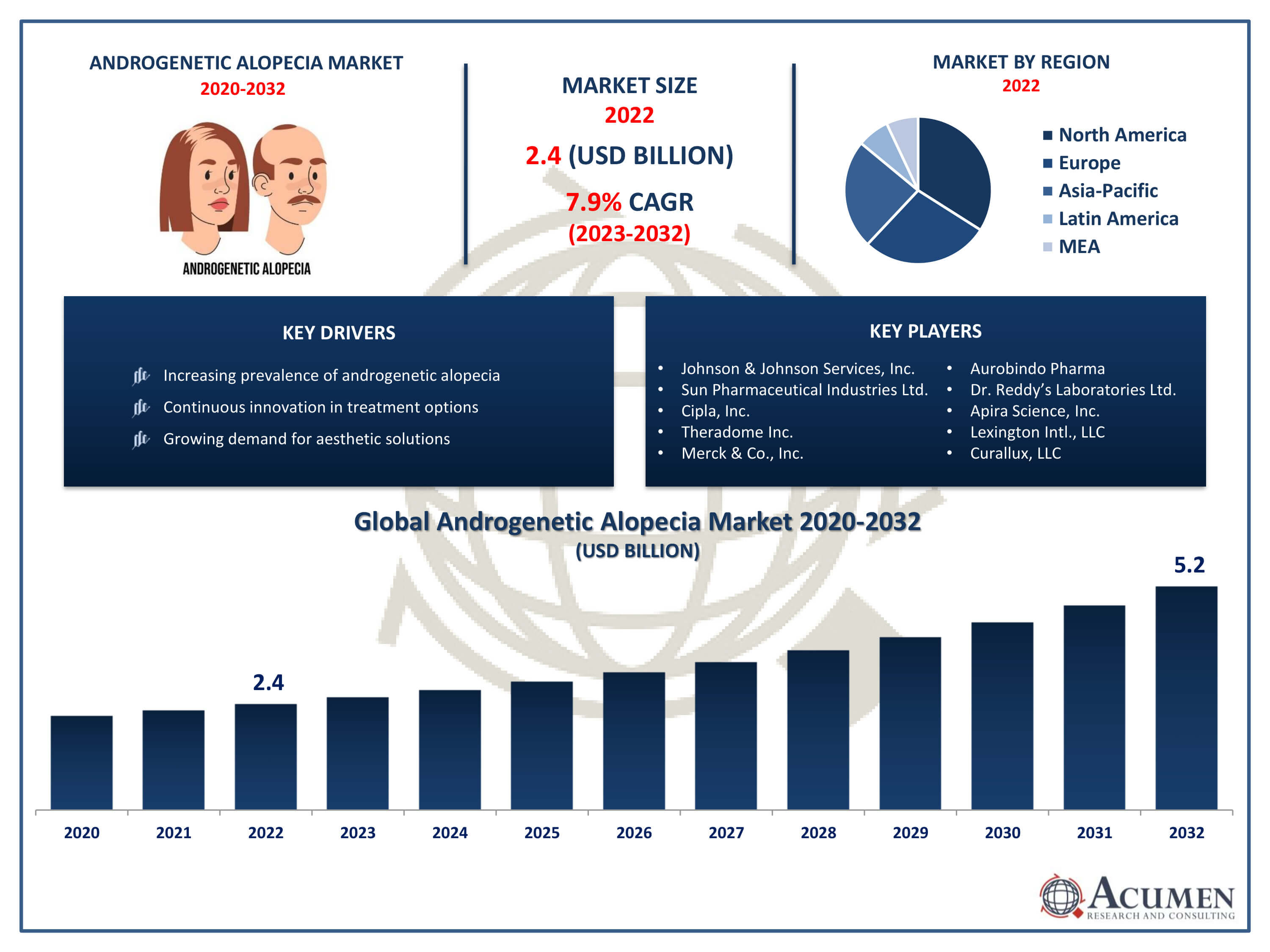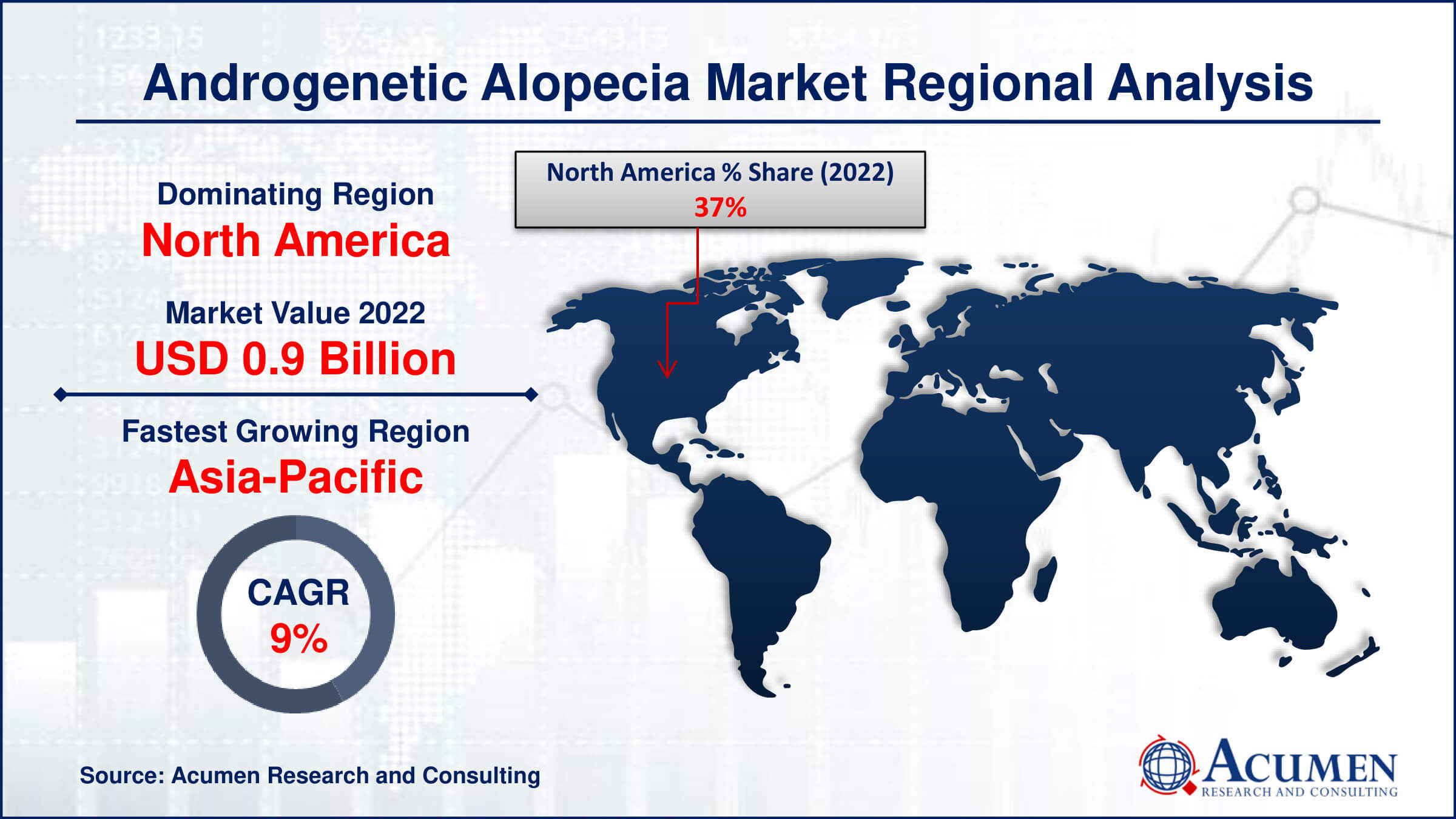April 2023
Androgenetic Alopecia Market Size accounted for USD 2.4 Billion in 2022 and is projected to achieve a market size of USD 5.2 Billion by 2032 growing at a CAGR of 7.9% from 2023 to 2032.
The Androgenetic Alopecia Market Size accounted for USD 2.4 Billion in 2022 and is projected to achieve a market size of USD 5.2 Billion by 2032 growing at a CAGR of 7.9% from 2023 to 2032.
Androgenetic Alopecia Market Highlights

Androgenetic alopecia, commonly known as male or female pattern baldness, is a prevalent form of hair loss characterized by a progressive thinning of hair in a distinct pattern. It is primarily driven by genetic and hormonal factors, specifically the hormone dihydrotestosterone (DHT), which causes hair follicles to shrink over time, leading to shorter and finer hair growth cycles. While it affects both men and women, it tends to manifest differently in each gender, with men typically experiencing a receding hairline and eventual balding at the crown, while women often notice widening part lines and overall thinning of the hair.
The market for treatments targeting androgenetic alopecia has experienced significant growth in recent years, driven by increasing awareness of the condition and advancements in treatment options. This growth is propelled by a variety of factors, including the expanding aging population, the rising prevalence of androgenetic alopecia due to changing lifestyles and environmental factors, and the growing demand for effective solutions to address hair loss concerns. Additionally, the emergence of novel therapeutic approaches such as topical formulations, oral medications, and advanced surgical techniques like hair transplantation has contributed to the expansion of the market.
Global Androgenetic Alopecia Market Trends
Market Drivers
Market Restraints
Market Opportunities
Androgenetic Alopecia Market Report Coverage
| Market | Androgenetic Alopecia Market |
| Androgenetic Alopecia Market Size 2022 | USD 2.4 Billion |
| Androgenetic Alopecia Market Forecast 2032 |
USD 5.2 Billion |
| Androgenetic Alopecia Market CAGR During 2023 - 2032 | 7.9% |
| Androgenetic Alopecia Market Analysis Period | 2020 - 2032 |
| Androgenetic Alopecia Market Base Year |
2022 |
| Androgenetic Alopecia Market Forecast Data | 2023 - 2032 |
| Segments Covered | By Gender, By Treatment, By End-use, By Sales Channel, And By Geography |
| Regional Scope | North America, Europe, Asia Pacific, Latin America, and Middle East & Africa |
| Key Companies Profiled | Johnson & Johnson Services, Inc., Sun Pharmaceutical Industries Ltd., Cipla, Inc., Theradome Inc., Merck & Co., Inc., Aurobindo Pharma, Dr. Reddy’s Laboratories Ltd., Apira Science, Inc., Lexington Intl., LLC, Curallux, LLC, and Freedom Laser Therapy, Inc. |
| Report Coverage |
Market Trends, Drivers, Restraints, Competitive Analysis, Player Profiling, Covid-19 Analysis, Regulation Analysis |
Androgenetic alopecia, often referred to as male or female pattern baldness, is a common form of hair loss characterized by a progressive thinning of hair on the scalp. It is primarily influenced by genetic and hormonal factors, specifically the hormone dihydrotestosterone (DHT). DHT binds to receptors in the hair follicles, causing them to shrink over time and resulting in shorter and finer hair growth cycles. This process eventually leads to a visible reduction in hair density and the characteristic pattern of baldness, which differs between men and women. In men, androgenetic alopecia typically manifests as a receding hairline and thinning at the crown, while women may experience overall thinning of the hair with a widening of the part line. The applications of understanding androgenetic alopecia span various sectors, including healthcare, pharmaceuticals, and cosmetic industries. In healthcare, it guides clinicians in diagnosing and managing hair loss conditions, providing patients with personalized treatment plans based on the underlying causes and severity of their alopecia.
The market for androgenetic alopecia treatments has seen significant growth in recent years and is expected to continue expanding at a rapid pace. This growth is driven by several factors, including the increasing prevalence of androgenetic alopecia worldwide, particularly as a consequence of changing lifestyles, environmental factors, and an aging population. As more individuals are affected by hair loss, there is a growing demand for effective solutions to address this concern, propelling the market forward. Additionally, advancements in treatment options, including topical formulations, oral medications, and surgical techniques like hair transplantation, have fueled market growth. These innovations offer patients a wider range of choices to manage androgenetic alopecia, leading to increased adoption and market penetration. Moreover, heightened awareness about the psychological impact of hair loss and the desire for aesthetic improvements further contribute to the expansion of the market.
Androgenetic Alopecia Market Segmentation
The global androgenetic alopecia market segmentation is based on gender, treatment, end-use, sales channel, and geography.
Androgenetic Alopecia Market By Gender
According to the androgenetic alopecia industry analysis, the male segment accounted for the largest market share in 2022. This growth is primarily due to the higher prevalence of hair loss in men compared to women. Male pattern baldness, a common manifestation of androgenetic alopecia in men, affects a substantial portion of the male population globally. As a result, there has been a considerable demand for treatments specifically tailored to address the needs of men experiencing hair loss, leading to significant market growth within this segment. Advancements in treatment options, such as topical solutions containing minoxidil or finasteride, have been particularly impactful in catering to the male segment of the market. These treatments have shown efficacy in slowing down hair loss and promoting hair regrowth in many men, thereby driving adoption rates and contributing to market expansion. Additionally, the increasing acceptance of hair transplantation as a viable long-term solution for male pattern baldness has further fueled market growth within the male segment.
Androgenetic Alopecia Market By Treatment
In terms of treatments, the pharmaceuticals segment is expected to witness significant growth in the coming years. Pharmaceutical companies have been investing in research and development to bring forth innovative treatments targeting the underlying causes of androgenetic alopecia, such as hormonal imbalances and genetic predispositions. This has resulted in the introduction of topical formulations, oral medications, and combination therapies that have shown promising results in slowing down hair loss and promoting hair regrowth. One significant contributor to the growth of the pharmaceuticals segment is the rising prevalence of androgenetic alopecia globally, affecting both men and women across different age groups. As awareness about the condition increases and individuals seek medical assistance for hair loss management, there is a growing market for pharmaceutical products addressing these needs.
Androgenetic Alopecia Market By End-use
According to the androgenetic alopecia market forecast, the homecare settings segment is expected to witness significant growth in the coming years. One significant driver is the convenience and comfort offered by homecare solutions, allowing individuals to manage their hair loss concerns in the privacy of their own homes without the need for frequent visits to healthcare facilities. This trend has been further accelerated by the COVID-19 pandemic, which has led to a greater reliance on telemedicine and remote care options, including virtual consultations and online prescription services for hair loss treatments. Advancements in technology and product innovation have also played a crucial role in driving growth within the homecare settings segment. The availability of over-the-counter topical formulations, such as minoxidil-based solutions and scalp stimulating serums, allows individuals to easily access and incorporate these treatments into their daily grooming routines.
Androgenetic Alopecia Market By Sales Channel
Based on the sales channel, the OTC segment is expected to continue its growth trajectory in the coming years. This growth is driven by several factors contributing to the increasing popularity of self-administered treatments for hair loss. One key driver is the accessibility and convenience offered by OTC products, which can be purchased without a prescription and used in the comfort of one's home. This accessibility has democratized access to hair loss treatments, allowing individuals to take proactive measures to address their concerns without the need for medical consultations or visits to healthcare facilities. Advancements in formulation technologies and product innovation have also contributed to the growth of the OTC segment, with the introduction of topical solutions, foams, and shampoos containing active ingredients such as minoxidil and botanical extracts known to promote hair growth. These products provide consumers with a variety of options to choose from based on their preferences and hair care needs, further driving market expansion.
Androgenetic Alopecia Market Regional Outlook
North America
Europe
Asia-Pacific
Latin America
The Middle East & Africa

Androgenetic Alopecia Market Regional Analysis
North America stands out as a dominating region in the androgenetic alopecia market due to several key factors contributing to its significant growth and market leadership. One primary factor is the high prevalence of androgenetic alopecia within the region, affecting a substantial portion of the population, both men and women. This heightened prevalence has spurred a greater demand for effective treatments, driving market growth. Additionally, North America boasts a robust healthcare infrastructure with advanced medical facilities, skilled healthcare professionals, and extensive research and development capabilities. This facilitates the development and adoption of innovative treatments for androgenetic alopecia, positioning the region at the forefront of market advancements. Furthermore, North America is home to a large pharmaceutical industry with leading companies investing heavily in research and development initiatives focused on hair loss therapies. These investments have resulted in the introduction of novel treatment options and the expansion of product portfolios catering to the diverse needs of individuals experiencing hair loss. Moreover, the region's strong regulatory framework ensures the safety and efficacy of marketed products, instilling confidence among consumers and healthcare professionals alike.
Androgenetic Alopecia Market Player
Some of the top androgenetic alopecia market companies offered in the professional report include Johnson & Johnson Services, Inc., Sun Pharmaceutical Industries Ltd., Cipla, Inc., Theradome Inc., Merck & Co., Inc., Aurobindo Pharma, Dr. Reddy’s Laboratories Ltd., Apira Science, Inc., Lexington Intl., LLC, Curallux, LLC, and Freedom Laser Therapy, Inc.
Looking for discounts, bulk pricing, or custom solutions? Contact us today at sales@acumenresearchandconsulting.com
April 2023
December 2019
December 2024
August 2020